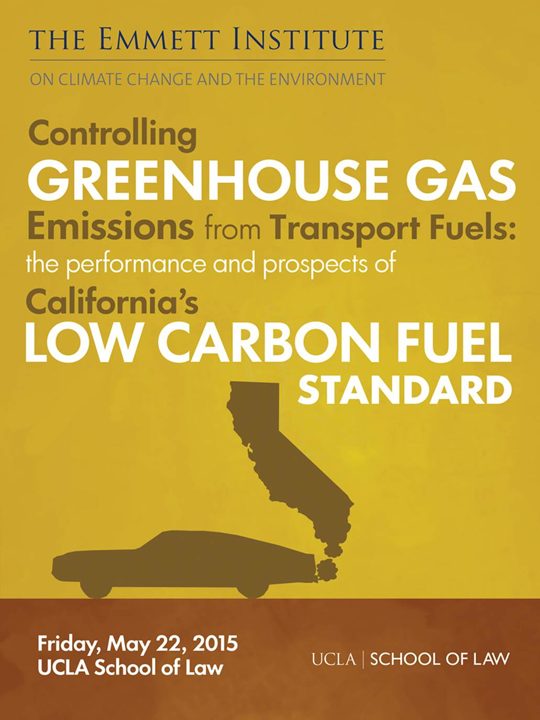Controlling Greenhouse Gas Emissions from Transport Fuels
The Performance and Prospects of California’s Low-Carbon Fuel Standard
Transportation is the largest contributor of greenhouse gas emissions in California, responsible for about 37 percent of the state’s total emissions. This distinction makes the sector a prime target for regulation. But with tens of millions of emitting tailpipes, fuels sourced from out of state and around the world, decades-long vehicle lifespans, and many other complicating factors, it’s a hard area to regulate.
Policymakers have settled on a few ways to cut transport emissions. Most of these are aimed at lowering fuel consumption, either by reducing total miles traveled or increasing fuel efficiency. But these mechanisms can only get us so far, particularly because many GHGs associated with transportation are emitted before a vehicle’s wheels even begin to turn, farther up along the fuel supply chain.
These emissions are the focus of California’s Low Carbon Fuel Standard (LCFS), a program of the California Air Resources Board that seeks to lower the carbon intensity (CI) of the fuels used in transportation by targeting emissions generated throughout the lifecycle of these fuels. The program is ambitious—it aims to achieve a 10 percent CI reduction by 2020—and innovative—it is the first policy to incorporate lifecycle assessment. It is also controversial—the program has faced strong criticism particularly from the oil industry, and is the subject of protracted litigation under state and federal lawsuits.
Last Friday, UCLA’s Emmett Institute hosted a workshop-style public conference, Controlling Greenhouse Gas Emissions from Transport Fuels: The Performance and Prospects of California’s Low-Carbon Fuel Standard, to discuss the legal and policy dimensions of the LCFS. The day’s discussions looked at the current state of the program—where it stands, and how it got there—and also to the future, looking at the continuing challenges to reach the targeted reductions, and at how the LCFS can contribute to stricter economy-wide targets being developed for after 2020.
We’ve been delighted with the results of this conference. Our panelists—uniquely qualified stakeholders from academia, government, and private and nonprofit sectors (see full agenda)—dug into the deep issues of the program with a concentrated attention that has probably not taken place in other public discussions of the LCFS to date. Other important voices from the audience contributed substantially to the exchange. Initial feedback on the discussion has been strongly positive. (A big thank-you to our excellent panelists and audience participants and everyone who made this event such a success!)
We’re still parsing the big lessons of the day, but we’re excited to share the results in a forthcoming follow-up briefing. For now, a very quick recap of some of the main discussion points, for those who couldn’t attend. The conference was organized around three panels, which explored particular aspects of the LCFS program. Each discussion assumed a base level of knowledge set out in a background paper for the conference (which will also be useful to anyone who wants to get a basic understanding of the LCFS design and trajectory).
The first panel explored policy design issues. Much of the discussion surrounded technology and resource neutrality, a primary goal of the program. Conference convener and moderator Ted Parson framed the issue as three questions: “Is it? Is it really? Should it be?” That is, does the program achieve neutrality, both as written and implemented, and moreover, is this neutrality the best policy? On its face, the LCFS is aimed singularly at reducing the CI of California fuels, leaving questions of which fuels and production pathways are best suited to do this to the competitive market. In popular political parlance, the LCFS avoids “picking winners and losers.” But in practice, the program may be friendlier to certain fuels. Gasoline and diesel are the big examples—unlike other fuels, the CI of petroleum fuels is determined on a statewide average basis, which means the incentive to find lower-CI petroleum fuels is strongly diminished. Whether and how the policy should target finer CI reductions of these fuels remains an open question—explored but not reconciled at the conference.
The second panel featured a two-fold discussion of how the LCFS interacts with other policies, and how the program can be expanded to other jurisdictions. The panel looked at how the LCFS fits with the California’s cap-and-trade program and the federal Renewable Fuel Standard, including what the respective roles and purposes of these two policies are and should be, and how the two policies influence each other in practice. Looking outside the state, the panelists considered California’s goal of expanding its policy elsewhere—including the ways that this goal may shape the state’s own policy design objectives, and ongoing efforts to make the LCFS model work in Washington and Oregon.
The third panel looked at legal issues of the LCFS program. Central to this discussion were the constitutional challenges brought in Rocky Mountain Farmers Union v. Corey (see Ann Carlson’s earlier Legal Planet recap of this case), which saved the policy from a district court’s finding of that the program violated the dormant commerce clause of the U.S. Constitution. As stressed by the panelists, this decision was critical for the success of the LCFS model and other state climate policies, both in California and elsewhere. And it remains a potential shaping factor: litigation in the wake of the decision continues, as a district court considers remaining issues. Oregon’s newly adopted LCFS is now facing a similar set of challenges that could also impact the LCFS and other alternative fuel policies. The Supreme Court has so far declined to review Rocky Mountain Farmers, but it could still get involved in either the California or Oregon litigation.
UC Davis Professor Dan Sperling—the primary architect of the LCFS program—delivered closing remarks, reflecting on the day’s discussion and the state and future of the program.
We look forward to sharing additional information from this discussion in the future. Watch this blog for more details on the follow-up paper.








Reader Comments